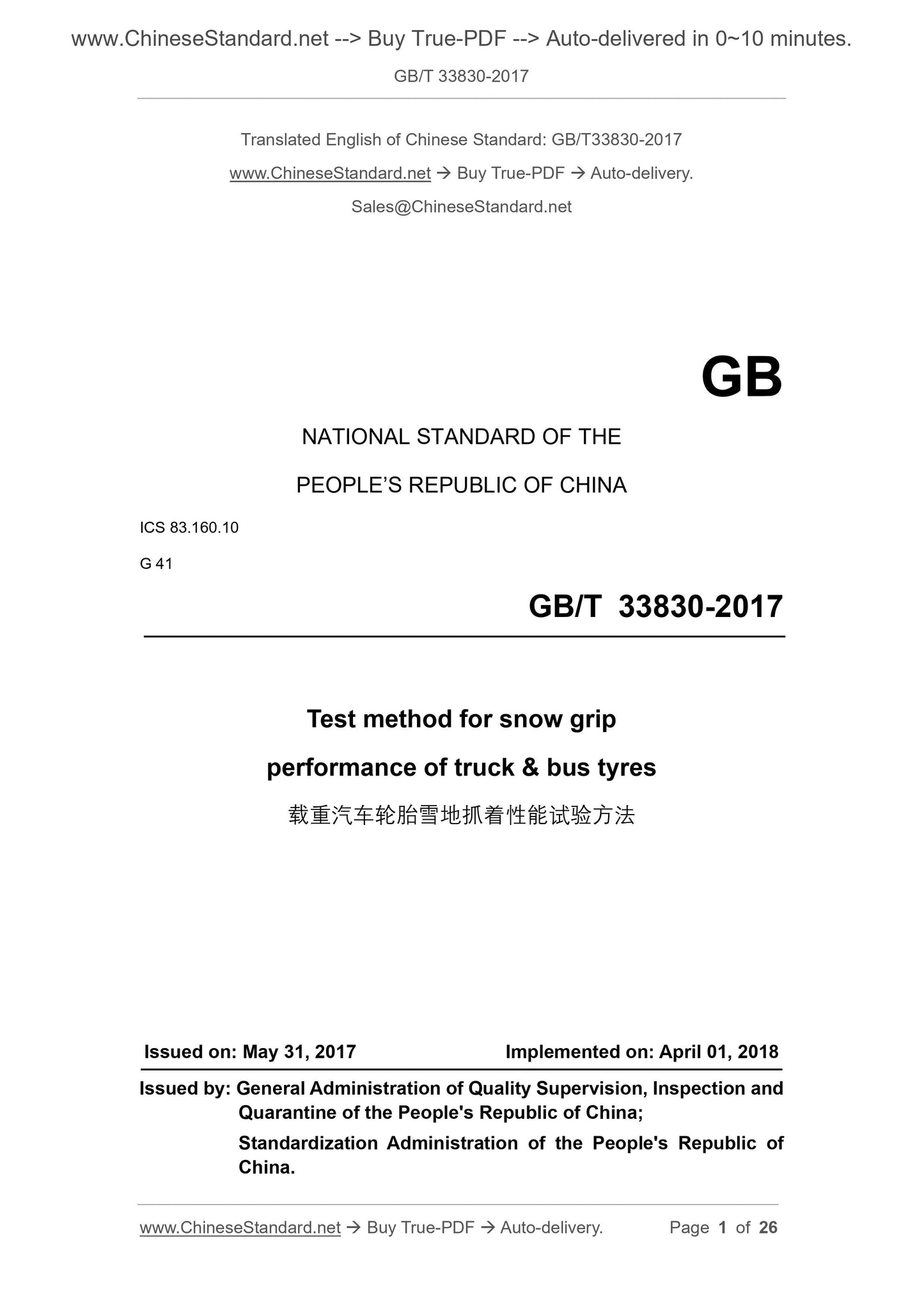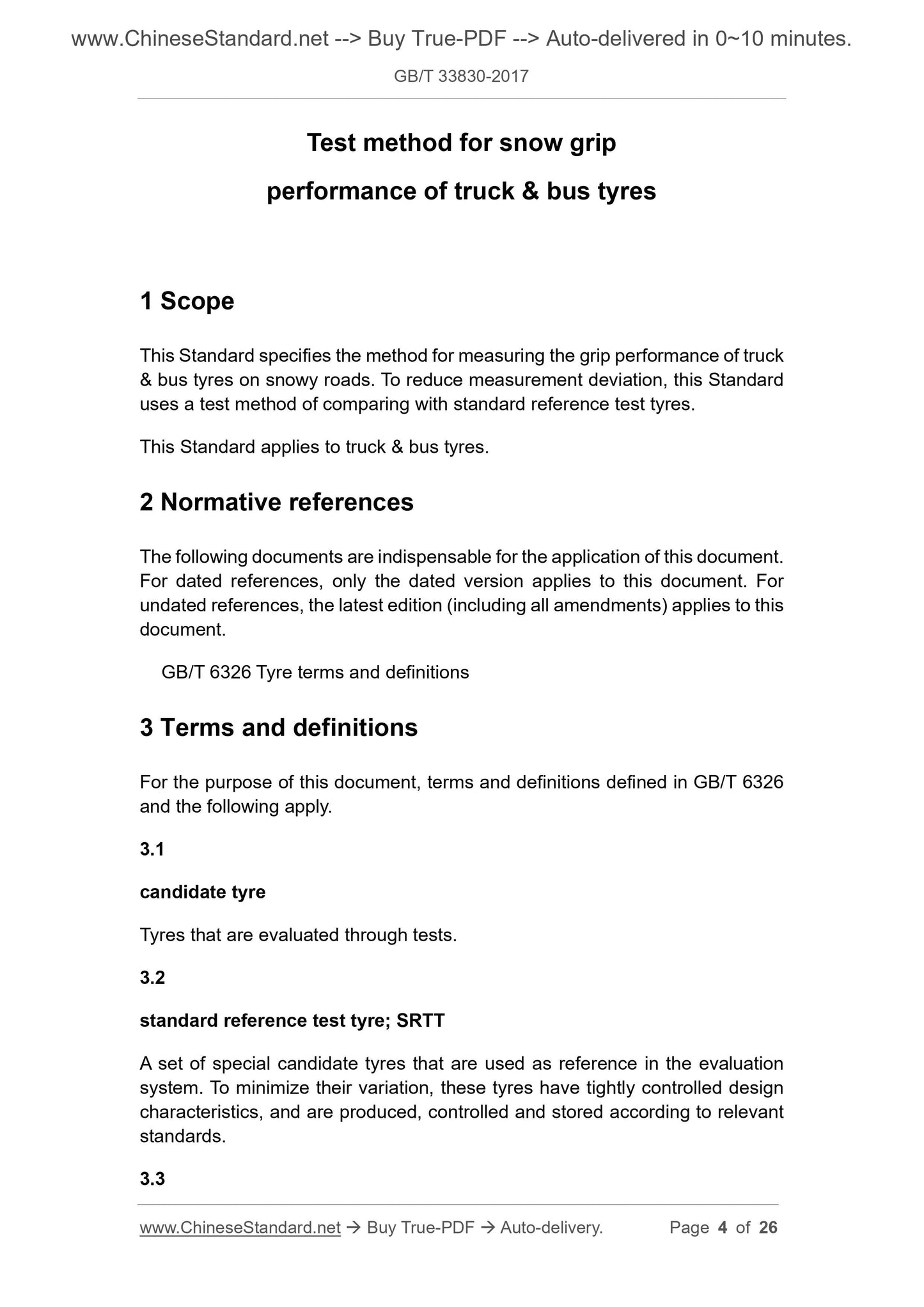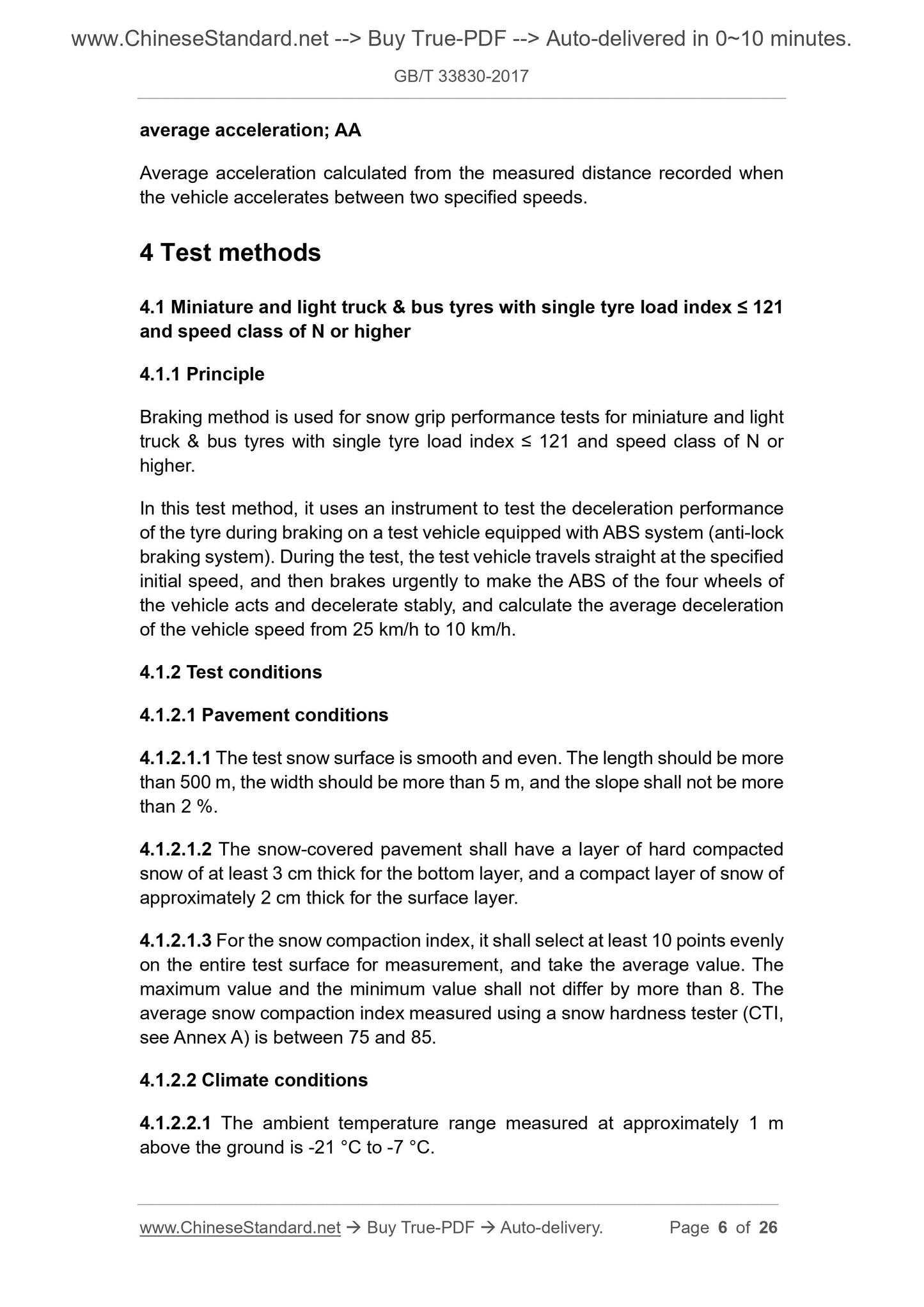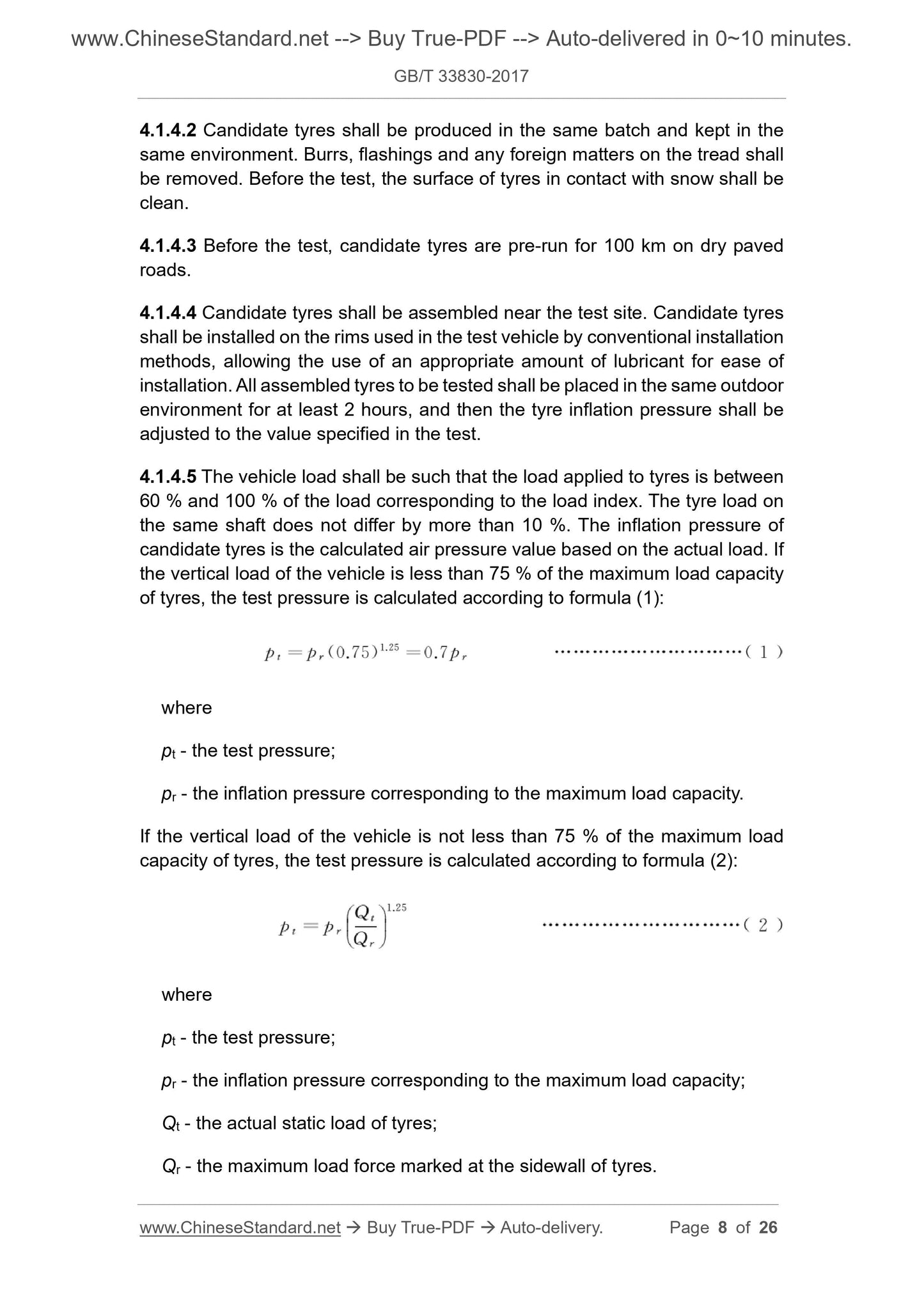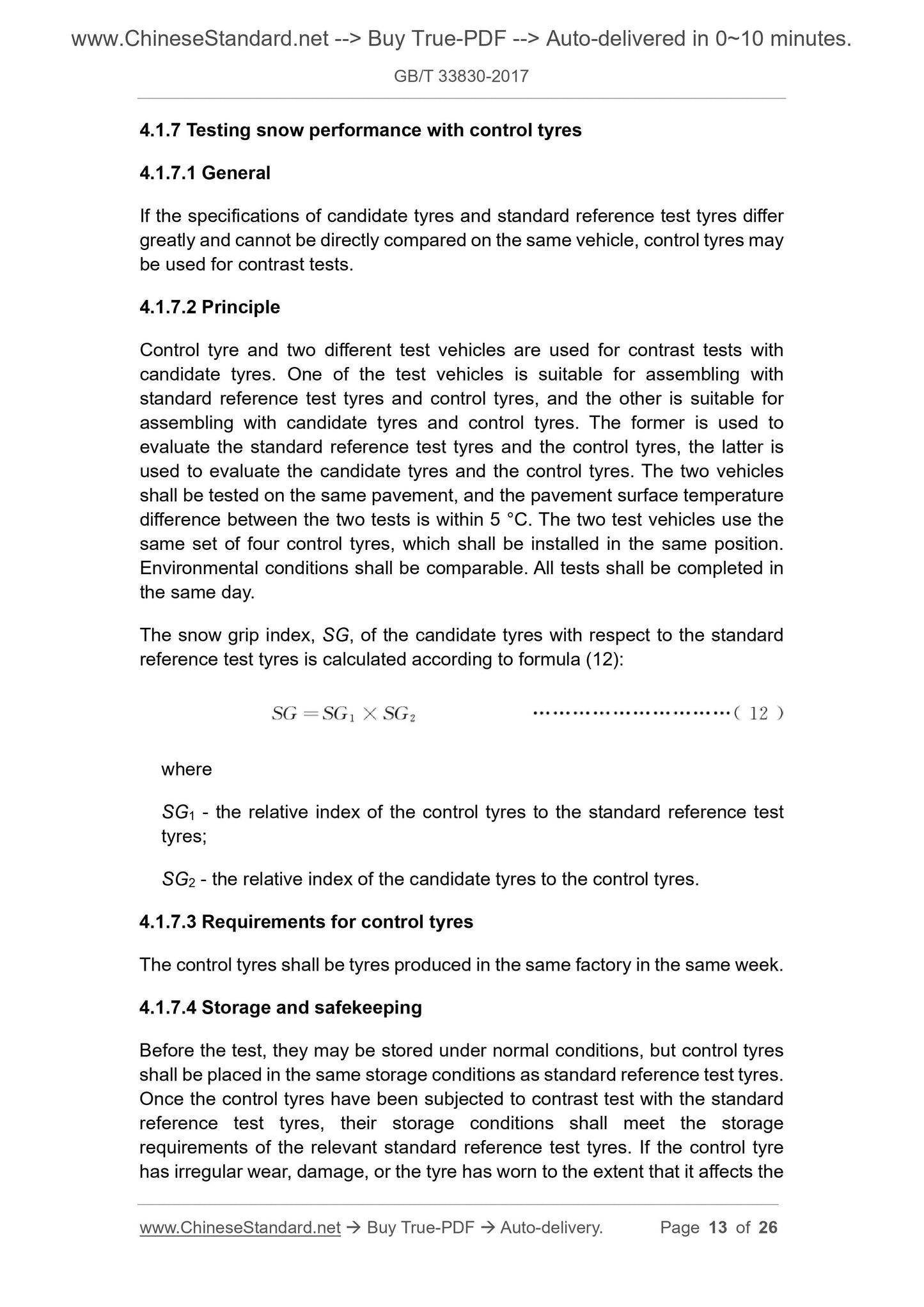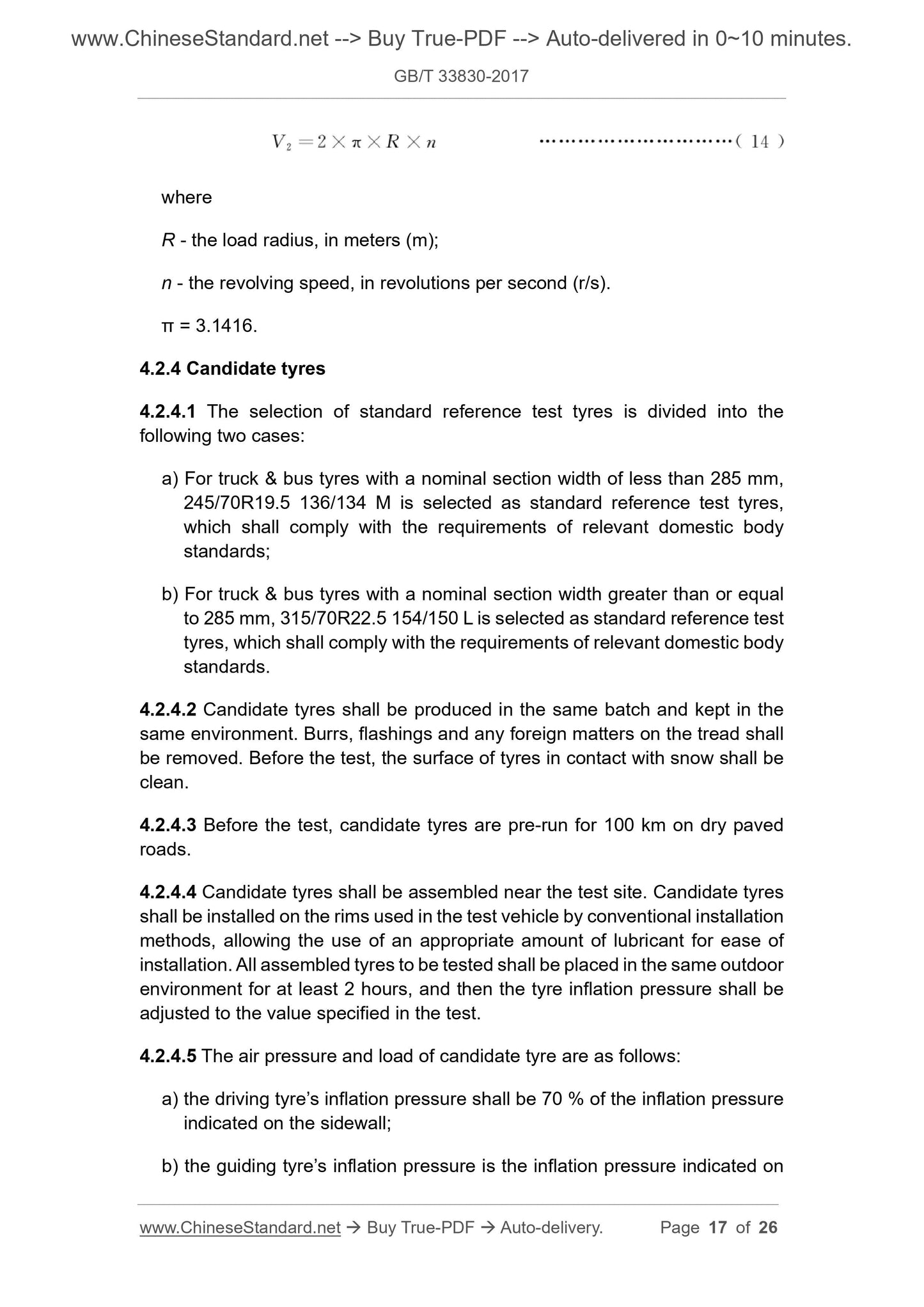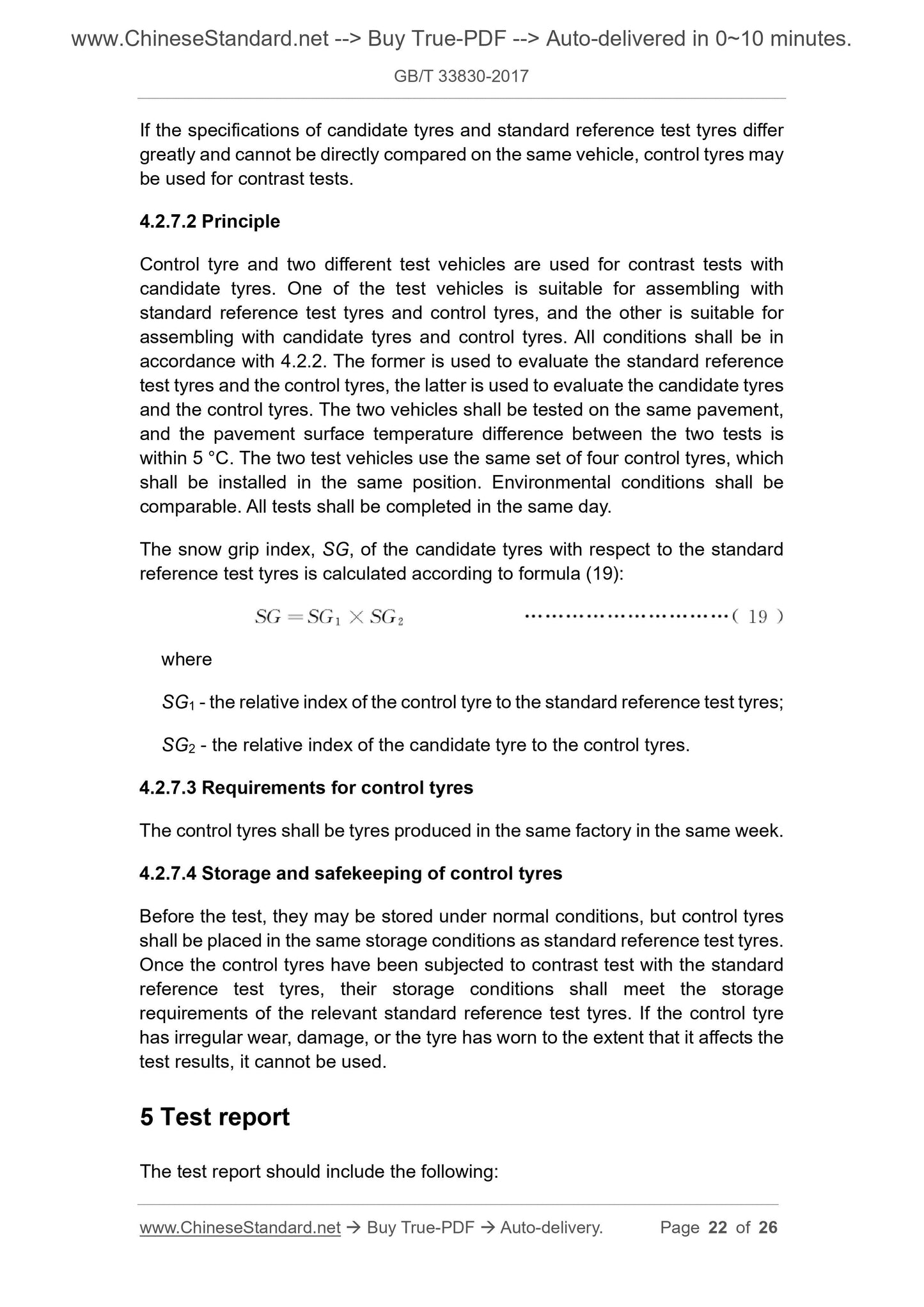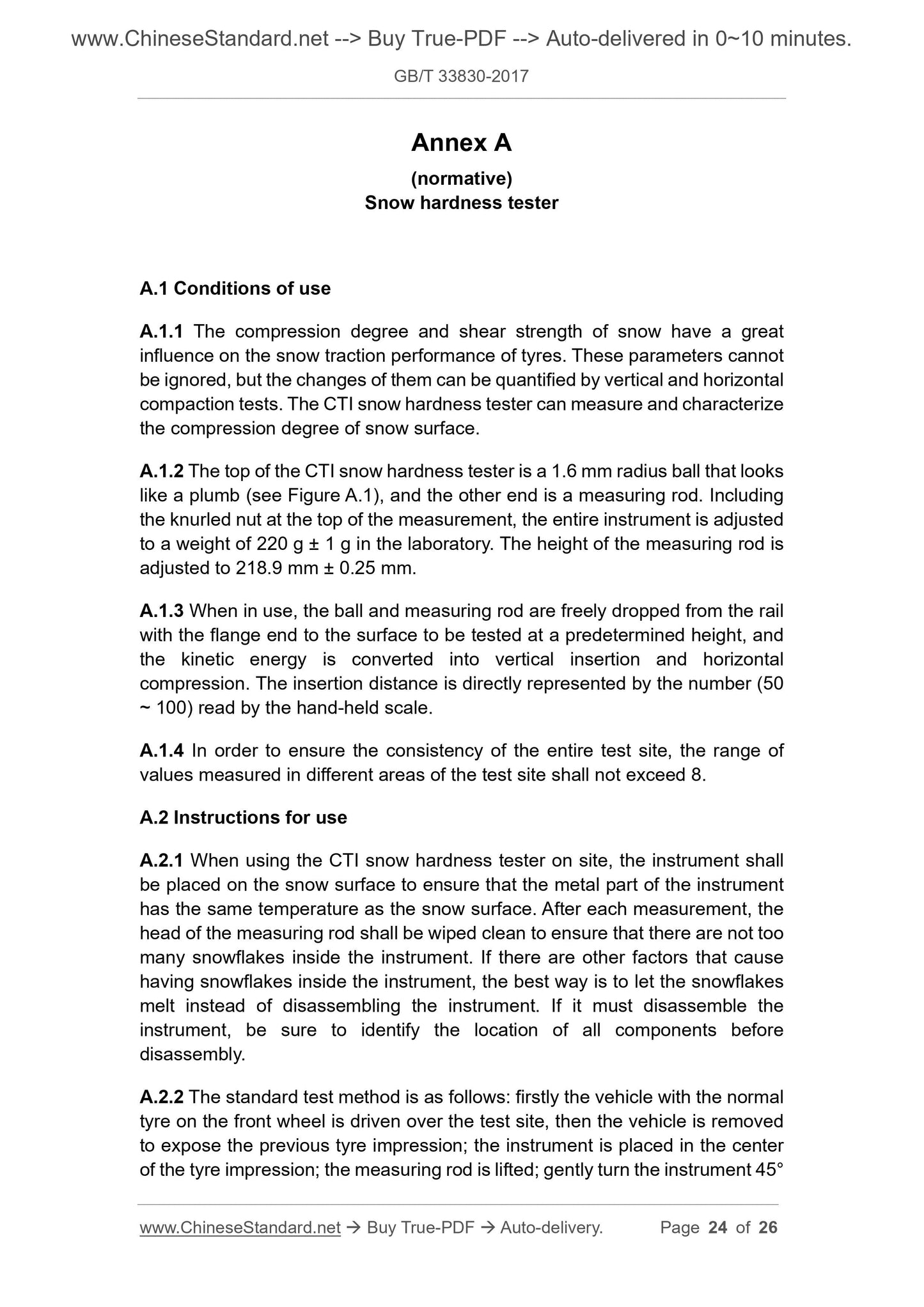1
/
of
10
www.ChineseStandard.us -- Field Test Asia Pte. Ltd.
GB/T 33830-2017 English PDF (GB/T33830-2017)
GB/T 33830-2017 English PDF (GB/T33830-2017)
Regular price
$255.00
Regular price
Sale price
$255.00
Unit price
/
per
Shipping calculated at checkout.
Couldn't load pickup availability
GB/T 33830-2017: Test method for snow grip performance of truck and bus tyres
Delivery: 9 seconds. Download (& Email) true-PDF + Invoice.
Get Quotation: Click GB/T 33830-2017 (Self-service in 1-minute)
Historical versions (Master-website): GB/T 33830-2017
Preview True-PDF (Reload/Scroll-down if blank)
GB/T 33830-2017
NATIONAL STANDARD OF THE
PEOPLE’S REPUBLIC OF CHINA
ICS 83.160.10
G 41
Test method for snow grip
performance of truck and bus tyres
ISSUED ON: MAY 31, 2017
IMPLEMENTED ON: APRIL 01, 2018
Issued by: General Administration of Quality Supervision, Inspection and
Quarantine of the People's Republic of China;
Standardization Administration of the People's Republic of
China.
Table of Contents
Foreword ... 3
1 Scope ... 4
2 Normative references ... 4
3 Terms and definitions ... 4
4 Test methods ... 6
5 Test report ... 22
Annex A (normative) Snow hardness tester ... 24
Test method for snow grip
performance of truck and bus tyres
1 Scope
This Standard specifies the method for measuring the grip performance of truck
and bus tyres on snowy roads. To reduce measurement deviation, this Standard
uses a test method of comparing with standard reference test tyres.
This Standard applies to truck and bus tyres.
2 Normative references
The following documents are indispensable for the application of this document.
For dated references, only the dated version applies to this document. For
undated references, the latest edition (including all amendments) applies to this
document.
GB/T 6326 Tyre terms and definitions
3 Terms and definitions
For the purpose of this document, terms and definitions defined in GB/T 6326
and the following apply.
3.1
candidate tyre
Tyres that are evaluated through tests.
3.2
standard reference test tyre; SRTT
A set of special candidate tyres that are used as reference in the evaluation
system. To minimize their variation, these tyres have tightly controlled design
characteristics, and are produced, controlled and stored according to relevant
standards.
3.3
average acceleration; AA
Average acceleration calculated from the measured distance recorded when
the vehicle accelerates between two specified speeds.
4 Test methods
4.1 Miniature and light truck and bus tyres with single tyre load index ≤ 121
and speed class of N or higher
4.1.1 Principle
Braking method is used for snow grip performance tests for miniature and light
truck and bus tyres with single tyre load index ≤ 121 and speed class of N or
higher.
In this test method, it uses an instrument to test the deceleration performance
of the tyre during braking on a test vehicle equipped with ABS system (anti-lock
braking system). During the test, the test vehicle travels straight at the specified
initial speed, and then brakes urgently to make the ABS of the four wheels of
the vehicle acts and decelerate stably, and calculate the average deceleration
of the vehicle speed from 25 km/h to 10 km/h.
4.1.2 Test conditions
4.1.2.1 Pavement conditions
4.1.2.1.1 The test snow surface is smooth and even. The length should be more
than 500 m, the width should be more than 5 m, and the slope shall not be more
than 2 %.
4.1.2.1.2 The snow-covered pavement shall have a layer of hard compacted
snow of at least 3 cm thick for the bottom layer, and a compact layer of snow of
approximately 2 cm thick for the surface layer.
4.1.2.1.3 For the snow compaction index, it shall select at least 10 points evenly
on the entire test surface for measurement, and take the average value. The
maximum value and the minimum value shall not differ by more than 8. The
average snow compaction index measured using a snow hardness tester (CTI,
see Annex A) is between 75 and 85.
4.1.2.2 Climate conditions
4.1.2.2.1 The ambient temperature range measured at approximately 1 m
above the ground is -21 °C to -7 °C.
4.1.4.2 Candidate tyres shall be produced in the same batch and kept in the
same environment. Burrs, flashings and any foreign matters on the tread shall
be removed. Before the test, the surface of tyres in contact with snow shall be
clean.
4.1.4.3 Before the test, candidate tyres are pre-run for 100 km on dry paved
roads.
4.1.4.4 Candidate tyres shall be assembled near the test site. Candidate tyres
shall be installed on the rims used in the test vehicle by conventional installation
methods, allowing the use of an appropriate amount of lubricant for ease of
installation. All assembled tyres to be tested shall be placed in the same outdoor
environment for at least 2 hours, and then the tyre inflation pressure shall be
adjusted to the value specified in the test.
4.1.4.5 The vehicle load shall be such that the load applied to tyres is between
60 % and 100 % of the load corresponding to the load index. The tyre load on
the same shaft does not differ by more than 10 %. The inflation pressure of
candidate tyres is the calculated air pressure value based on the actual load. If
the vertical load of the vehicle is less than 75 % of the maximum load capacity
of tyres, the test pressure is calculated according to formula (1):
where
pt - the test pressure;
pr - the inflation pressure corresponding to the maximum load capacity.
If the vertical load of the vehicle is not less than 75 % of the maximum load
capacity of tyres, the test pressure is calculated according to formula (2):
where
pt - the test pressure;
pr - the inflation pressure corresponding to the maximum load capacity;
Qt - the actual static load of tyres;
Qr - the maximum load force marked at the sidewall of tyres.
4.1.7 Testing snow performance with control tyres
4.1.7.1 General
If the specifications of candidate tyres and standard reference test tyres differ
greatly and cannot be directly compared on the same vehicle, control tyres may
be used for contrast tests.
4.1.7.2 Principle
Control tyre and two different test vehicles are used for contrast tests with
candidate tyres. One of the test vehicles is suitable for assembling with
standard reference test tyres and control tyres, and the other is suitable for
assembling with candidate tyres and control tyres. The former is used to
evaluate the standard reference test tyres and the control tyres, the latter is
used to evaluate the candidate tyres and the control tyres. The two vehicles
shall be tested on the same pavement, and the pavement surface temperature
difference between the two tests is within 5 °C. The two test vehicles use the
same set of four control tyres, which shall be installed in the same position.
Environmental conditions shall be comparable. All tests shall be completed in
the same day.
The snow grip index, SG, of the candidate tyres with respect to the standard
reference test tyres is calculated according to formula (12):
where
SG1 - the relative index of the control tyres to the standard reference test
tyres;
SG2 - the relative index of the candidate tyres to the control tyres.
4.1.7.3 Requirements for control tyres
The control tyres shall be tyres produced in the same factory in the same week.
4.1.7.4 Storage and safekeeping
Before the test, they may be stored under normal conditions, but control tyres
shall be placed in the same storage conditions as standard reference test tyres.
Once the control tyres have been subjected to contrast test with the standard
reference test tyres, their storage conditions shall meet the storage
requirements of the relevant standard reference test tyres. If the control tyre
has irregular wear, damage, or the tyre has worn to the extent that it affects the
4.2.2.2.3 During the test, the temperature change shall not exceed 10 °C.
4.2.2.2.4 During the test, try to avoid direct sunlight and large changes in
sunshine or humidity. The wind speed should not exceed 5 m/s.
4.2.2.3 Test vehicle conditions
4.2.2.3.1 The test shall be carried out on a two-shaft standard commercial
vehicle in good working condition. The vehicle shall:
a) have a lower rear shaft weight and an engine with sufficient power, to
ensure that the average slip ratio during the test complies with the
requirements of 4.2.5.3 and 4.2.5.4;
b) the transmission ratio of the manual transmission (automatic transmission
that allows manual shifting) shall cover a range of at least 19 km/h
between 4 km/h and 30 km/h;
c) it is recommended to install a differential lock on the drive shaft to improve
repeatability;
d) the test vehicle shall be equipped with a traction control system (ASR,
TCS).
4.2.2.3.2 In the special case where a standard commercial vehicle equipped
with a traction control system cannot be found, if the vehicle is equipped with a
system capable of displaying the slip ratio specified in 4.2.3.5 and a differential
lock is installed on the drive shaft, it is allowed to use vehicles without traction
control system (ASR, TCS).
4.2.2.3.3 The test vehicle shall be equipped with a calibrated sensor for winter
measurements, and the speed and distance data acquisition system shall have
the function of storing measurement results. The accuracy of the sensor and
system shall be such that the relative uncertainty of the measured or calculated
mean fully developed deceleration is less than 1 %.
4.2.2.3.4 The following modifications are possible:
a) After the vehicle is modified, the tyre specifications that can be installed
on the vehicle can be increased;
b) After the vehicle is modified, the automatic acceleration starter and
measuring device can be installed.
No other modifications to the acceleration system shall be made.
4.2.2.3.5 Vehicle assembly: Two or four candidate tyres can be mounted on the
where
R - the load radius, in meters (m);
n - the revolving speed, in revolutions per second (r/s).
π = 3.1416.
4.2.4 Candidate tyres
4.2.4.1 The selection of standard reference test tyres is divided into the
following two cases:
a) For truck and bus tyres with a nominal section width of less than 285 mm,
245/70R19.5 136/134 M is selected as standard reference test tyres,
which shall comply with the requirements of relevant domestic body
standards;
b) For truck and bus tyres with a nominal section width greater than or equal
to 285 mm, 315/70R22.5 154/150 L is selected as standard reference test
tyres, which shall comply with the requirements of relevant domestic body
standards.
4.2.4.2 Candidate tyres shall be produced in the same batch and kept in the
same environment. Burrs, flashings and any foreign matters on the tread shall
be removed. Before the test, the surface of tyres in contact with snow shall be
clean.
4.2.4.3 Before the test, candidate tyres are pre-run for 100 km on dry paved
roads.
4.2.4.4 Candidate tyres shall be assembled near the test site. Candidate tyres
shall be installed on the rims used in the test vehicle by conventional installation
methods, allowing the use of an appropriate amount of lubricant for ease of
installation. All assembled tyres to be tested shall be placed in the same outdoor
environment for at least 2 hours, and then the tyre inflation pressure shall be
adjusted to the value specified in the test.
4.2.4.5 The air pressure and load of candidate tyre are as follows:
a) the driving tyre’s inflation pressure shall be 70 % of the inflation pressure
indicated on the sidewall;
b) the guiding tyre’s inflation pressure is the inflation pressure indicated on
If the specifications of candidate tyres and standard reference test tyres differ
greatly and cannot be directly compared on the same vehicle, control tyres may
be used for contrast tests.
4.2.7.2 Principle
Control tyre and two different test vehicles are used for contrast tests with
candidate tyres. One of the test vehicles is suitable for assembling with
standard reference test tyres and control tyres, and the other is suitable for
assembling with candidate tyres and control tyres. All conditions shall be in
accordance with 4.2.2. The former is used to evaluate the standard reference
test tyres and the control tyres, the latter is used to evaluate the candidate tyres
and the control tyres. The two vehicles shall be tested on the same pavement,
and the pavement surface temperature difference between the two tests is
within 5 °C. The two test vehicles use the same set of four control tyres, which
shall be installed in the same position. Environmental conditions shall be
comparable. All tests shall be completed in the same day.
The snow grip index, SG, of the candidate tyres with respect to the standard
reference test tyres is calculated according to formula (19):
where
SG1 - the relative index of the control tyre to the standard reference test tyres;
SG2 - the relative index of the candidate tyre to the control tyres.
4.2.7.3 Requirements for control tyres
The control tyres shall be tyres produced in the same factory in the same week.
4.2.7.4 Storage and safekeeping of control tyres
Before the test, they may be stored under normal conditions, but control tyres
shall be placed in the same storage conditions as standard reference test tyres.
Once the control tyres have been subjected to contrast test with the standard
reference test tyres, their storage conditions shall meet the storage
requirements of the relevant standard reference test tyres. If the control tyre
has irregular wear, damage, or the tyre has worn to the extent that it affects the
test results, it cannot be used.
5 Test report
The test report should include the following:
Annex A
(normative)
Snow hardness tester
A.1 Conditions of use
A.1.1 The compression degree and shear strength of snow have a great
influence on the snow traction performance of tyres. These parameters cannot
be ignored, but the changes of them can be quantified by vertical and horizontal
compaction tests. The CTI snow hardness tester can measure and characterize
the compression degree of snow surface.
A.1.2 The top of the CTI snow hardness tester is a 1.6 mm radius ball that looks
like a plumb (see Figure A.1), and the other end is a measuring rod. Including
the knurled nut at the top of the measurement, the entire instrument is adjusted
to a weight of 220 g ± 1 g in the laboratory. The height of the measuring rod is
adjusted to 218.9 mm ± 0.25 mm.
...
Delivery: 9 seconds. Download (& Email) true-PDF + Invoice.
Get Quotation: Click GB/T 33830-2017 (Self-service in 1-minute)
Historical versions (Master-website): GB/T 33830-2017
Preview True-PDF (Reload/Scroll-down if blank)
GB/T 33830-2017
NATIONAL STANDARD OF THE
PEOPLE’S REPUBLIC OF CHINA
ICS 83.160.10
G 41
Test method for snow grip
performance of truck and bus tyres
ISSUED ON: MAY 31, 2017
IMPLEMENTED ON: APRIL 01, 2018
Issued by: General Administration of Quality Supervision, Inspection and
Quarantine of the People's Republic of China;
Standardization Administration of the People's Republic of
China.
Table of Contents
Foreword ... 3
1 Scope ... 4
2 Normative references ... 4
3 Terms and definitions ... 4
4 Test methods ... 6
5 Test report ... 22
Annex A (normative) Snow hardness tester ... 24
Test method for snow grip
performance of truck and bus tyres
1 Scope
This Standard specifies the method for measuring the grip performance of truck
and bus tyres on snowy roads. To reduce measurement deviation, this Standard
uses a test method of comparing with standard reference test tyres.
This Standard applies to truck and bus tyres.
2 Normative references
The following documents are indispensable for the application of this document.
For dated references, only the dated version applies to this document. For
undated references, the latest edition (including all amendments) applies to this
document.
GB/T 6326 Tyre terms and definitions
3 Terms and definitions
For the purpose of this document, terms and definitions defined in GB/T 6326
and the following apply.
3.1
candidate tyre
Tyres that are evaluated through tests.
3.2
standard reference test tyre; SRTT
A set of special candidate tyres that are used as reference in the evaluation
system. To minimize their variation, these tyres have tightly controlled design
characteristics, and are produced, controlled and stored according to relevant
standards.
3.3
average acceleration; AA
Average acceleration calculated from the measured distance recorded when
the vehicle accelerates between two specified speeds.
4 Test methods
4.1 Miniature and light truck and bus tyres with single tyre load index ≤ 121
and speed class of N or higher
4.1.1 Principle
Braking method is used for snow grip performance tests for miniature and light
truck and bus tyres with single tyre load index ≤ 121 and speed class of N or
higher.
In this test method, it uses an instrument to test the deceleration performance
of the tyre during braking on a test vehicle equipped with ABS system (anti-lock
braking system). During the test, the test vehicle travels straight at the specified
initial speed, and then brakes urgently to make the ABS of the four wheels of
the vehicle acts and decelerate stably, and calculate the average deceleration
of the vehicle speed from 25 km/h to 10 km/h.
4.1.2 Test conditions
4.1.2.1 Pavement conditions
4.1.2.1.1 The test snow surface is smooth and even. The length should be more
than 500 m, the width should be more than 5 m, and the slope shall not be more
than 2 %.
4.1.2.1.2 The snow-covered pavement shall have a layer of hard compacted
snow of at least 3 cm thick for the bottom layer, and a compact layer of snow of
approximately 2 cm thick for the surface layer.
4.1.2.1.3 For the snow compaction index, it shall select at least 10 points evenly
on the entire test surface for measurement, and take the average value. The
maximum value and the minimum value shall not differ by more than 8. The
average snow compaction index measured using a snow hardness tester (CTI,
see Annex A) is between 75 and 85.
4.1.2.2 Climate conditions
4.1.2.2.1 The ambient temperature range measured at approximately 1 m
above the ground is -21 °C to -7 °C.
4.1.4.2 Candidate tyres shall be produced in the same batch and kept in the
same environment. Burrs, flashings and any foreign matters on the tread shall
be removed. Before the test, the surface of tyres in contact with snow shall be
clean.
4.1.4.3 Before the test, candidate tyres are pre-run for 100 km on dry paved
roads.
4.1.4.4 Candidate tyres shall be assembled near the test site. Candidate tyres
shall be installed on the rims used in the test vehicle by conventional installation
methods, allowing the use of an appropriate amount of lubricant for ease of
installation. All assembled tyres to be tested shall be placed in the same outdoor
environment for at least 2 hours, and then the tyre inflation pressure shall be
adjusted to the value specified in the test.
4.1.4.5 The vehicle load shall be such that the load applied to tyres is between
60 % and 100 % of the load corresponding to the load index. The tyre load on
the same shaft does not differ by more than 10 %. The inflation pressure of
candidate tyres is the calculated air pressure value based on the actual load. If
the vertical load of the vehicle is less than 75 % of the maximum load capacity
of tyres, the test pressure is calculated according to formula (1):
where
pt - the test pressure;
pr - the inflation pressure corresponding to the maximum load capacity.
If the vertical load of the vehicle is not less than 75 % of the maximum load
capacity of tyres, the test pressure is calculated according to formula (2):
where
pt - the test pressure;
pr - the inflation pressure corresponding to the maximum load capacity;
Qt - the actual static load of tyres;
Qr - the maximum load force marked at the sidewall of tyres.
4.1.7 Testing snow performance with control tyres
4.1.7.1 General
If the specifications of candidate tyres and standard reference test tyres differ
greatly and cannot be directly compared on the same vehicle, control tyres may
be used for contrast tests.
4.1.7.2 Principle
Control tyre and two different test vehicles are used for contrast tests with
candidate tyres. One of the test vehicles is suitable for assembling with
standard reference test tyres and control tyres, and the other is suitable for
assembling with candidate tyres and control tyres. The former is used to
evaluate the standard reference test tyres and the control tyres, the latter is
used to evaluate the candidate tyres and the control tyres. The two vehicles
shall be tested on the same pavement, and the pavement surface temperature
difference between the two tests is within 5 °C. The two test vehicles use the
same set of four control tyres, which shall be installed in the same position.
Environmental conditions shall be comparable. All tests shall be completed in
the same day.
The snow grip index, SG, of the candidate tyres with respect to the standard
reference test tyres is calculated according to formula (12):
where
SG1 - the relative index of the control tyres to the standard reference test
tyres;
SG2 - the relative index of the candidate tyres to the control tyres.
4.1.7.3 Requirements for control tyres
The control tyres shall be tyres produced in the same factory in the same week.
4.1.7.4 Storage and safekeeping
Before the test, they may be stored under normal conditions, but control tyres
shall be placed in the same storage conditions as standard reference test tyres.
Once the control tyres have been subjected to contrast test with the standard
reference test tyres, their storage conditions shall meet the storage
requirements of the relevant standard reference test tyres. If the control tyre
has irregular wear, damage, or the tyre has worn to the extent that it affects the
4.2.2.2.3 During the test, the temperature change shall not exceed 10 °C.
4.2.2.2.4 During the test, try to avoid direct sunlight and large changes in
sunshine or humidity. The wind speed should not exceed 5 m/s.
4.2.2.3 Test vehicle conditions
4.2.2.3.1 The test shall be carried out on a two-shaft standard commercial
vehicle in good working condition. The vehicle shall:
a) have a lower rear shaft weight and an engine with sufficient power, to
ensure that the average slip ratio during the test complies with the
requirements of 4.2.5.3 and 4.2.5.4;
b) the transmission ratio of the manual transmission (automatic transmission
that allows manual shifting) shall cover a range of at least 19 km/h
between 4 km/h and 30 km/h;
c) it is recommended to install a differential lock on the drive shaft to improve
repeatability;
d) the test vehicle shall be equipped with a traction control system (ASR,
TCS).
4.2.2.3.2 In the special case where a standard commercial vehicle equipped
with a traction control system cannot be found, if the vehicle is equipped with a
system capable of displaying the slip ratio specified in 4.2.3.5 and a differential
lock is installed on the drive shaft, it is allowed to use vehicles without traction
control system (ASR, TCS).
4.2.2.3.3 The test vehicle shall be equipped with a calibrated sensor for winter
measurements, and the speed and distance data acquisition system shall have
the function of storing measurement results. The accuracy of the sensor and
system shall be such that the relative uncertainty of the measured or calculated
mean fully developed deceleration is less than 1 %.
4.2.2.3.4 The following modifications are possible:
a) After the vehicle is modified, the tyre specifications that can be installed
on the vehicle can be increased;
b) After the vehicle is modified, the automatic acceleration starter and
measuring device can be installed.
No other modifications to the acceleration system shall be made.
4.2.2.3.5 Vehicle assembly: Two or four candidate tyres can be mounted on the
where
R - the load radius, in meters (m);
n - the revolving speed, in revolutions per second (r/s).
π = 3.1416.
4.2.4 Candidate tyres
4.2.4.1 The selection of standard reference test tyres is divided into the
following two cases:
a) For truck and bus tyres with a nominal section width of less than 285 mm,
245/70R19.5 136/134 M is selected as standard reference test tyres,
which shall comply with the requirements of relevant domestic body
standards;
b) For truck and bus tyres with a nominal section width greater than or equal
to 285 mm, 315/70R22.5 154/150 L is selected as standard reference test
tyres, which shall comply with the requirements of relevant domestic body
standards.
4.2.4.2 Candidate tyres shall be produced in the same batch and kept in the
same environment. Burrs, flashings and any foreign matters on the tread shall
be removed. Before the test, the surface of tyres in contact with snow shall be
clean.
4.2.4.3 Before the test, candidate tyres are pre-run for 100 km on dry paved
roads.
4.2.4.4 Candidate tyres shall be assembled near the test site. Candidate tyres
shall be installed on the rims used in the test vehicle by conventional installation
methods, allowing the use of an appropriate amount of lubricant for ease of
installation. All assembled tyres to be tested shall be placed in the same outdoor
environment for at least 2 hours, and then the tyre inflation pressure shall be
adjusted to the value specified in the test.
4.2.4.5 The air pressure and load of candidate tyre are as follows:
a) the driving tyre’s inflation pressure shall be 70 % of the inflation pressure
indicated on the sidewall;
b) the guiding tyre’s inflation pressure is the inflation pressure indicated on
If the specifications of candidate tyres and standard reference test tyres differ
greatly and cannot be directly compared on the same vehicle, control tyres may
be used for contrast tests.
4.2.7.2 Principle
Control tyre and two different test vehicles are used for contrast tests with
candidate tyres. One of the test vehicles is suitable for assembling with
standard reference test tyres and control tyres, and the other is suitable for
assembling with candidate tyres and control tyres. All conditions shall be in
accordance with 4.2.2. The former is used to evaluate the standard reference
test tyres and the control tyres, the latter is used to evaluate the candidate tyres
and the control tyres. The two vehicles shall be tested on the same pavement,
and the pavement surface temperature difference between the two tests is
within 5 °C. The two test vehicles use the same set of four control tyres, which
shall be installed in the same position. Environmental conditions shall be
comparable. All tests shall be completed in the same day.
The snow grip index, SG, of the candidate tyres with respect to the standard
reference test tyres is calculated according to formula (19):
where
SG1 - the relative index of the control tyre to the standard reference test tyres;
SG2 - the relative index of the candidate tyre to the control tyres.
4.2.7.3 Requirements for control tyres
The control tyres shall be tyres produced in the same factory in the same week.
4.2.7.4 Storage and safekeeping of control tyres
Before the test, they may be stored under normal conditions, but control tyres
shall be placed in the same storage conditions as standard reference test tyres.
Once the control tyres have been subjected to contrast test with the standard
reference test tyres, their storage conditions shall meet the storage
requirements of the relevant standard reference test tyres. If the control tyre
has irregular wear, damage, or the tyre has worn to the extent that it affects the
test results, it cannot be used.
5 Test report
The test report should include the following:
Annex A
(normative)
Snow hardness tester
A.1 Conditions of use
A.1.1 The compression degree and shear strength of snow have a great
influence on the snow traction performance of tyres. These parameters cannot
be ignored, but the changes of them can be quantified by vertical and horizontal
compaction tests. The CTI snow hardness tester can measure and characterize
the compression degree of snow surface.
A.1.2 The top of the CTI snow hardness tester is a 1.6 mm radius ball that looks
like a plumb (see Figure A.1), and the other end is a measuring rod. Including
the knurled nut at the top of the measurement, the entire instrument is adjusted
to a weight of 220 g ± 1 g in the laboratory. The height of the measuring rod is
adjusted to 218.9 mm ± 0.25 mm.
...
Share
